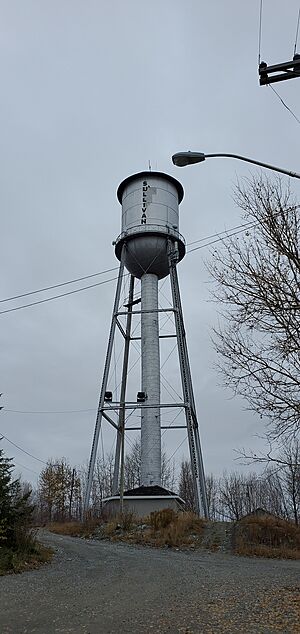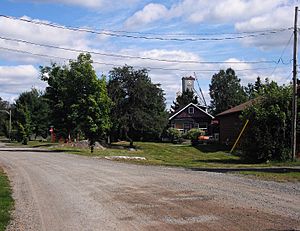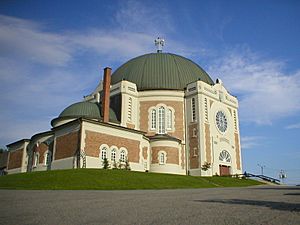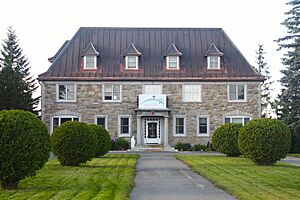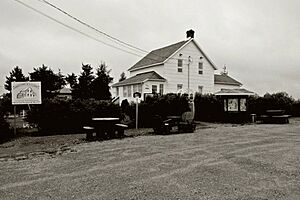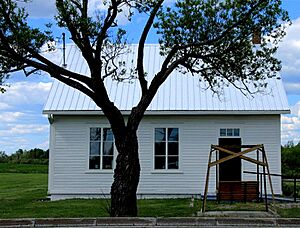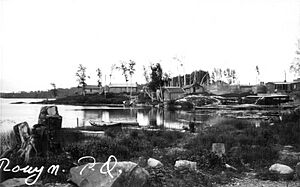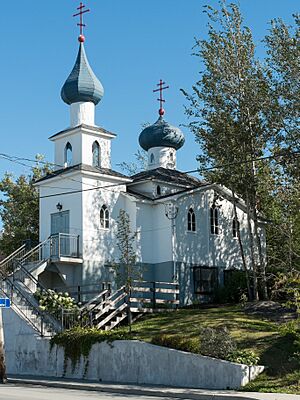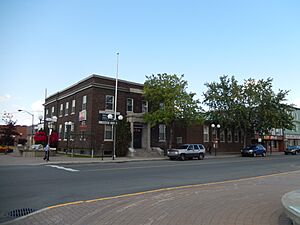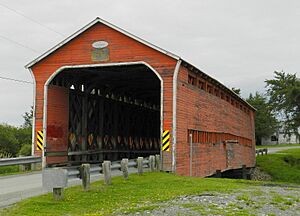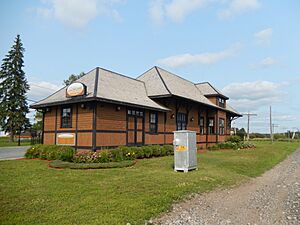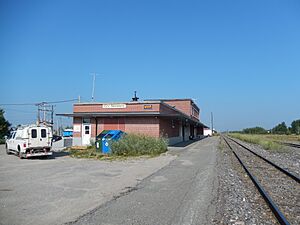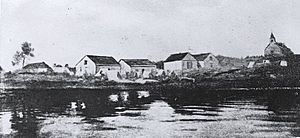List of historic places in Abitibi-Témiscamingue facts for kids
Abitibi-Témiscamingue is a special region in Quebec, Canada, full of amazing historic places! These places are like windows into the past, showing us how people lived, worked, and built communities long ago. They are officially recognized on the Canadian Register of Historic Places, which means they are important parts of Canada's story.
This article will take you on a journey through some of these cool spots, from old mines and schools to bridges and train stations. Get ready to discover the history hidden in Abitibi-Témiscamingue!
Contents
Historic Buildings and Sites
Many buildings in Abitibi-Témiscamingue have incredible stories to tell. They show us how people lived and worked in the past.
Mining History in Val-d'Or
Val-d'Or is famous for its mining history, and you can still see parts of it today.
Sullivan Mine Water Tower
The Château d'eau de l'ancienne mine Sullivan in Val-d'Or is an old water tower from the Sullivan Mine. This mine was a big part of Val-d'Or's growth, and the water tower reminds us of the busy mining days. It's located at 456, Rue de l'Hotel-de-Ville.
Bourlamaque Mining Village
The Site historique du Village-Minier-de-Bourlamaque is a unique historic site also in Val-d'Or. It's a mining village that was built in the 1930s for workers at the Lamaque gold mine. Many of the original log houses are still there, making it feel like you've stepped back in time. It's located on Avenue Perreault.
Important Buildings in Amos
The city of Amos has several buildings that played key roles in its development.
Old Courthouse
The Ancien palais de justice (Old Courthouse) in Amos was once the main place for legal matters in the region. It's a beautiful building that shows the importance of law and order as the community grew. You can find it at 101, 3ieme Avenue Est.
Hector-Authier House
The Maison Hector-Authier and the Site de la maison Hector-Authier are both about the home of Hector Authier, a very important person in the history of Abitibi-Témiscamingue. He was a politician and helped develop the region. His house, located at 122, Rue Authier in Amos, is a reminder of his contributions.
Amos Cathedral
The Cathédrale d'Amos is a grand church in Amos. Cathedrals are often central to a city's history and community life, and this one is no different. It's located on Boulevard Monseigneur-Dudemaine.
Bishop's Palace
Near the cathedral is the Évêché d'Amos (Bishop's Palace). This building served as the residence and office for the bishop, showing the strong religious influence in the region's early days. It's at 450, Rue Principale Nord.
Other Notable Buildings
La Corne Nursing Station
The La Corne Nursing Station National Historic Site of Canada in La Corne was a vital place for healthcare in the early days of the region. It provided medical care to people living in remote areas. It's located at 339 Route 111.
Authier Schoolhouse
The École du Rang-II-d'Authier in Authier is an old schoolhouse. These small, one-room schools were where many children in rural areas learned to read and write. It's a great example of early education in Quebec. It's on Route 111.
Brother Moffet House
The Maison du Frère-Moffet in Ville-Marie is a historic house with a unique story. Brother Moffet was a missionary who played a big role in helping the local communities. The house is at 7, Rue Notre-Dame-de-Lourdes.
Dumulon House Site
The Site historique de la Maison-Dumulon in Rouyn-Noranda is another important historic house. It represents the early settlement and development of Rouyn-Noranda. It's located at 191, Avenue du Lac.
Saint-Georges Church
The Église Saint-Georges in Rouyn-Noranda is a beautiful church that has been a central part of the community for many years. It's at 201, Rue Tachereau Ouest.
Federal Building in Rouyn
The Federal Building in Rouyn is a significant government building. These buildings often housed important services and offices that helped manage the growing towns. It's at 97 Rue Perreault Est.
Historic Transportation
Transportation was key to developing Abitibi-Témiscamingue, and some historic sites show us how people and goods moved around.
Bridges
Champagne Bridge
The Pont Champagne in Val-d'Or is a historic bridge. Bridges are super important because they connect communities and allow people to travel easily. This one is on Chemin du Pont-Champagne.
Landry Bridge
The Pont Landry in Latulipe-et-Gaboury is another historic bridge. It helped people cross rivers and streams, making travel and trade possible in the early days. It's on Montee du 9e-Rang.
Train Stations
Train stations were once bustling hubs, bringing people and supplies to new towns.
Témiscaming Train Station
The Gare de Témiscaming in Temiscaming is a historic train station. Train travel was crucial for settling this region, bringing in new residents and resources. It's at 15, Rue Humphrey.
Macamic Train Station
The Canadian National Railway Station in Macamic is another important train station. It served as a gateway for people and goods arriving in Macamic. It's on Station Avenue.
Senneterre Train Station
The Canadian National Railways Station in Senneterre also played a big role in connecting the region by rail. It's located on 4th St. West.
Tugboat
T.-E.-Draper Tugboat
The Remorqueur T.-E.-Draper in Laverlochère-Angliers is a historic tugboat. Tugboats were essential for moving logs and other materials on the region's many lakes and rivers, especially for the logging industry. It's located at 11, Rue du T.-E.-Draper.
Other Historic Places
Apitipik National Historic Site
The Apitipik National Historic Site of Canada in Pikogan is located at the eastern end of Lake Abitibi. This site is important because it was once a trading post for the Hudson's Bay Company, where Indigenous peoples and European traders exchanged goods. It tells a story of early interactions and trade in the region.


